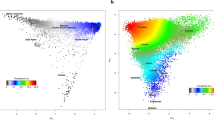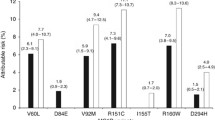Abstract
Patients with primary non-melanoma skin cancers (NMSCs) tend to develop these cancers at multiple independent sites. We examined the genetic factors in the development of multiple NMSCs among Caucasian women with 28 years of follow-up. We initially evaluated 19 SNPs in nine pigmentation genes with the number of NMSCs in 492 cases and 619 controls without a history of NMSC. We found nominal significant associations between two ASIP gene–related SNPs, rs1885120 and rs910873, and an ASIP haplotype (AH) (rs4911414 allele T and rs1015362 allele G) and an increased number of NMSCs, with p-values of 0.008, 0.01, and 0.01, respectively. We further evaluated these two SNPs and AH haplotype in three data sets. In a joint analysis with 1,507 cases and 4,335 controls, AH haplotype was independently associated with the number of NMSCs with odds ratio (OR) (95% confidence interval (CI)) of 1.45(1.25–1.68) (p-value = 6.2E–07). The AH haplotype was associated with an increased risk of developing one NMSC (OR 1.32; 95% CI, 1.07–1.63). The OR increased to 1.45(1.18–1.78) for those with 2–4 NMSCs and 1.84(1.34–2.53) for those with at least five. The findings suggest that ASIP locus is associated with the number of NMSCs.
Similar content being viewed by others
References
Jemal A, Siegel R, Ward E, Hao Y, Xu J, Thun MJ (2009) Cancer statistics, 2009. CA Cancer. J Clin 59(4):225–249
Rogers HW, Weinstock MA, Harris AR, Hinckley MR, Feldman SR, Fleischer AB et al (2010) Incidence estimate of nonmelanoma skin cancer in the United States, 2006. Arch Dermatol 146(3):283–287
Marcil I, Stern RS (2000) Risk of developing a subsequent nonmelanoma skin cancer in patients with a history of nonmelanoma skin cancer: a critical review of the literature and meta-analysis. Arch Dermatol 136(12):1524–1530
Heagerty AH, Fitzgerald D, Smith A, Bowers B, Jones P, Fryer AA, et al. (1994) Glutathione S-transferase GSTM1 phenotypes and protection against cutaneous tumours. Lancet. 29;343(8892):266–8
Ramachandran S, Hoban PR, Ichii-Jones F, Pleasants L, Ali-Osman F, Lear JT et al (2000) Glutathione S-transferase GSTP1 and cyclin D1 genotypes: association with numbers of basal cell carcinomas in a patient subgroup at high-risk of multiple tumours. Pharmacogenetics 10(6):545–556
Ramachandran S, Lear JT, Ramsay H, Smith AG, Bowers B, Hutchinson PE et al (1999) Presentation with multiple cutaneous basal cell carcinomas: association of glutathione S-transferase and cytochrome P450 genotypes with clinical phenotype. Cancer Epidemiol Biomarkers Prev 8(1):61–67
Lear JT, Heagerty AH, Smith A, Bowers B, Payne CR, Smith CA et al (1996) Multiple cutaneous basal cell carcinomas: glutathione S-transferase (GSTM1, GSTT1) and cytochrome P450 (CYP2D6, CYP1A1) polymorphisms influence tumour numbers and accrual. Carcinogenesis 17(9):1891–1896
Fryer AA, Ramsay HM, Lovatt TJ, Jones PW, Hawley CM, Nicol DL et al (2005) Polymorphisms in glutathione S-transferases and non-melanoma skin cancer risk in Australian renal transplant recipients. Carcinogenesis 26(1):185–191
Han J, Colditz GA, Hunter DJ (2006) Risk factors for skin cancers: a nested case-control study within the Nurses’ Health Study. Int J Epidemiol 35(6):1514–1521
Brown KM, Macgregor S, Montgomery GW, Craig DW, Zhao ZZ, Iyadurai K et al (2008) Common sequence variants on 20q11.22 confer melanoma susceptibility. Nat Genet 40(7):838–840
Fernandez LP, Milne RL, Pita G, Aviles JA, Lazaro P, Benitez J et al (2008) SLC45A2: a novel malignant melanoma-associated gene. Hum Mutat 29(9):1161–1167
Fernandez LP, Milne RL, Pita G, Floristan U, Sendagorta E, Feito M et al (2009) Pigmentation-related genes and their implication in malignant melanoma susceptibility. Exp Dermatol 18(7):634–642
Gudbjartsson DF, Sulem P, Stacey SN, Goldstein AM, Rafnar T, Sigurgeirsson B et al (2008) ASIP and TYR pigmentation variants associate with cutaneous melanoma and basal cell carcinoma. Nat Genet 40(7):886–891
Nan H, Kraft P, Hunter DJ, Han J (2009) Genetic variants in pigmentation genes, pigmentary phenotypes, and risk of skin cancer in Caucasians. Int J Cancer 125(4):909–917
Colditz GA, Martin P, Stampfer MJ, Willett WC, Sampson L, Rosner B et al (1986) Validation of questionnaire information on risk factors and disease outcomes in a prospective cohort study of women. Am J Epidemiol 123(5):894–900
Hunter DJ, Colditz GA, Stampfer MJ, Rosner B, Willett WC, Speizer FE (1990) Risk factors for basal cell carcinoma in a prospective cohort of women. Ann Epidemiol 1(1):13–23
Han J, Colditz GA, Liu JS, Hunter DJ (2005) Genetic variation in XPD, sun exposure, and risk of skin cancer. Cancer Epidemiol Biomarkers Prev 14(6):1539–1544
Hatoum IJ, Hu FB, Nelson JJ, Rimm EB (2010) Lipoprotein-associated phospholipase A2 activity and incident coronary heart disease among men and women with type 2 diabetes. Diabetes 59(5):1239–1243
Hunter DJ, Kraft P, Jacobs KB, Cox DG, Yeager M, Hankinson SE et al (2007) A genome-wide association study identifies alleles in FGFR2 associated with risk of sporadic postmenopausal breast cancer. Nat Genet 39(7):870–874
Qi L, Cornelis MC, Kraft P, Stanya KJ, Linda Kao WH, Pankow JS et al (2010) Genetic variants at 2q24 are associated with susceptibility to type 2 diabetes. Hum Mol Genet 19(13):2706–2715
Han J, Kraft P, Nan H, Guo Q, Chen C, Qureshi A et al (2008) A genome-wide association study identifies novel alleles associated with hair color and skin pigmentation. PLoS Genet 4(5):e1000074
Stokowski RP, Pant PV, Dadd T, Fereday A, Hinds DA, Jarman C et al (2007) A genomewide association study of skin pigmentation in a South Asian population. Am J Hum Genet 81(6):1119–1132
Sulem P, Gudbjartsson DF, Stacey SN, Helgason A, Rafnar T, Jakobsdottir M et al (2008) Two newly identified genetic determinants of pigmentation in Europeans. Nat Genet 40(7):835–837
Sulem P, Gudbjartsson DF, Stacey SN, Helgason A, Rafnar T, Magnusson KP et al (2007) Genetic determinants of hair, eye and skin pigmentation in Europeans. Nat Genet 39(12):1443–1452
Falush D, Stephens M, Pritchard JK (2003) Inference of population structure using multilocus genotype data: linked loci and correlated allele frequencies. Genetics 164(4):1567–1587
Kraft P, Cox DG, Paynter RA, Hunter D, De Vivo I (2005) Accounting for haplotype uncertainty in matched association studies: a comparison of simple and flexible techniques. Genet Epidemiol 28(3):261–272
Price AL, Patterson NJ, Plenge RM, Weinblatt ME, Shadick NA, Reich D (2006) Principal components analysis corrects for stratification in genome-wide association studies. Nat Genet 38(8):904–909
Patterson N, Price AL, Reich D (2006) Population structure and eigenanalysis. PLoS Genet 2(12):e190
Nan H, Qureshi AA, Han J (2010) Melanoma susceptibility variants on chromosome 20q11.22 are associated with pigmentary traits and the risk of nonmelanoma skin cancer. Br J Dermatol 162(2):461–463
Acknowledgments
We thank Dr. David J. Hunter for the open access to the breast cancer genome-wide SNP scan data set (part of the Cancer Genetic Markers of Susceptibility project). We thank Dr. Hardeep Ranu and Ms. Pati Soule of the Dana Farber/Harvard Cancer Center High-Throughput Polymorphism Detection Core for their laboratory assistance, and Ms. Constance Chen for genotyping imputation. We are also indebted to the participants in the Nurses’ Health Study for their dedication and commitment. (Grant Support: NIH CA122838 and CA128080.)
Conflicts of interest
The authors state no conflict of interest.
Author information
Authors and Affiliations
Corresponding author
Additional information
Wen Lin and Abrar A. Qureshi contribute equally.
Electronic supplementary material
Below is the link to the electronic supplementary material.
Rights and permissions
About this article
Cite this article
Lin, W., Qureshi, A.A., Kraft, P. et al. ASIP genetic variants and the number of non-melanoma skin cancers. Cancer Causes Control 22, 495–501 (2011). https://doi.org/10.1007/s10552-010-9724-1
Received:
Accepted:
Published:
Issue Date:
DOI: https://doi.org/10.1007/s10552-010-9724-1




